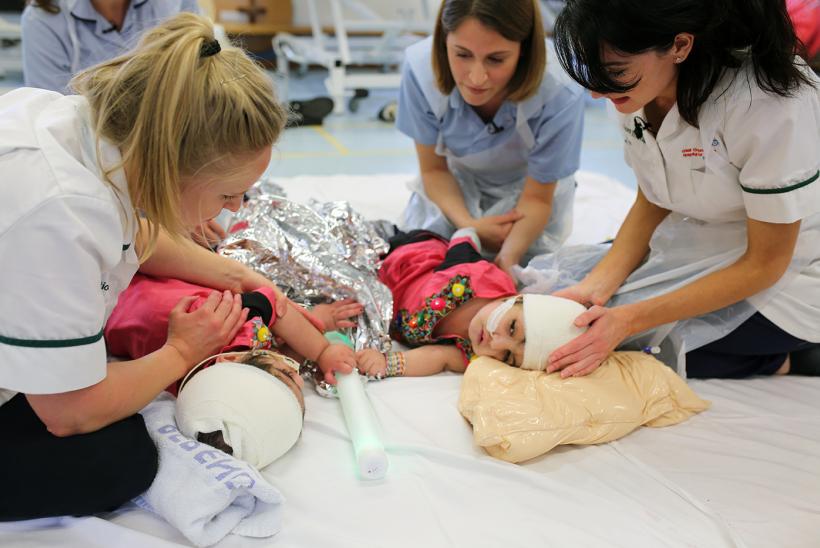Rare conjoined twins separated at Great Ormond Street Hospital
A set of twins joined at the top of the head have been successfully separated following pioneering surgery at Great Ormond Street Hospital (GOSH).
Separating sisters Safa and Marwa Ullah required three major operations and a number of lesser procedures. The major operations totalled more than 50 hours of surgery time, took place over a four-month period and involved a 100-strong team at the world-leading hospital. The first operation took place in October 2018 and the last operation, which saw the girls finally separated, took place on 11 February this year.
The two-year-olds from Charsadda in Pakistan, who were born by caesarean section, were craniopagus twins which means they were fused at the head – an incredibly rare condition.
Due to GOSH’s reputation as one of the only hospitals in the world with the expertise and experience to separate and care for craniopagus twins, the girls were brought to the London-based hospital from Pakistan for treatment when they were 19-months old.
The GOSH surgical and medical team, who also successfully separated craniopagus twins in 2011 and 2006, had the expertise and facilities to meticulously plan and carry out the series of complex and challenging operations and provide the high-level care Safa and Marwa needed.
GOSH experts used cutting-edge technology such as Virtual Reality (VR) and 3D printing to decide the best strategy and optimise chances of success. An exact replica of the girls’ anatomy was created in VR to help the surgeons visualise and understand the complex skulls and spatial relation between brains and blood vessels. 3D plastic models of the brains, skulls and blood vessels were then printed for practicing the surgery and building cutting guides to make the operations as smooth as possible.
The state-of-the-art technology and surgical techniques used for Safa and Marwa’s operations now give GOSH an opportunity to discover innovative ways of advancing clinical care and the clinical and research knowledge base that will benefit more children and young people in the future.
The 100-strong team was led by two world-leading surgeons. They were neurosurgeon Mr Noor ul Owase Jeelani and craniofacial surgeon Professor David Dunaway. The team included staff from over 15 disciplines across the hospital including plastic surgeons, anaesthetists, theatre nurses, operational department assistants, scientists and engineers with expertise in 3D modelling, VR technology and simulations.
The team also included dedicated paediatricians, ward nurses and allied health professionals including physiotherapists, occupational therapists and dietitians, who all played a vital part in the care and rehabilitation of the girls following their operations.
The twin’s mother Zainab Bibi said: “We are indebted to the hospital and to the staff and we would like to thank them for everything they have done. We are extremely excited about the future.”
Mr Jeelani, who was Head of Neurosurgery at GOSH from 2012 to 2018, and Professor Dunaway, Head of the Craniofacial Unit at GOSH, said: “We are delighted we have been able to help Safa and Marwa and their family. It has been a long and complex journey for them, and for the clinical team looking after them.
“From our personal point of view, it has been great to get to know the girls and their family. Their faith and determination have been so important in getting them through the challenges they have faced. We are incredibly proud of them.
“We are also incredibly proud of the GOSH team responsible for their treatment and care over the past 10 months. From the surgical teams, scientists and engineers who helped us plan and perform the operations to the paediatricians, nursing staff, physiotherapists and occupational therapists, it has been a huge team effort and every single person has played a key part in helping Safa and Marwa. GOSH really is one of the few hospitals in the world with the infrastructure and expertise to carry out a separation like this successfully.”
A team of theatre nurses also played crucial roles in the surgical planning and ensuring the operations went well.
Cecelia Carney, Team Leader, Neurosurgery Theatre, said: “Safa and Marwa’s surgeries highlighted to me the utmost importance of teamwork across the multidisciplinary team at GOSH. As always, this is necessary for us to deliver our high standard of care.
“The intricacies of the series of surgical procedures were planned meticulously as a team. We utilised the clinical expertise and the positive, proactive attitudes of our theatre practitioners. It has been an honour to work as a member of this team.”
The girls were discharged from GOSH on 1 July. They were transferred to a London address with their mother, grandfather and uncle where they continue to receive daily physiotherapy treatment as part of their ongoing rehabilitation.
Over the last six years, Mr Jeelani and Professor Dunaway have received over £1.3m from Great Ormond Street Hospital Children’s Charity for their Face Value programme – a vital area of research into new clinical techniques and equipment to improve the precision of craniofacial surgery. The Charity has supported further pioneering research by investing nearly £300,000 to help fund innovative techniques including VR, 3D planning and printing, which has been key in helping the team separate the twins. Money raised by GOSH Charity has also helped fund Theatre 10 at the hospital – a specialist theatre designed specifically for surgery on conjoined twins.
Facts and stats about craniopagus twins
- Conjoined twins are very rare - only one in every 2.5 million births
- Only 5% of conjoined twins are craniopagus
- About 40% of twins fused at the head are stillborn or die during labour
- A further third die within 24 hours
- The chance of craniopagus twins undergoing surgery is around one in 10 million
To learn about the twins and their story please visit this page.


